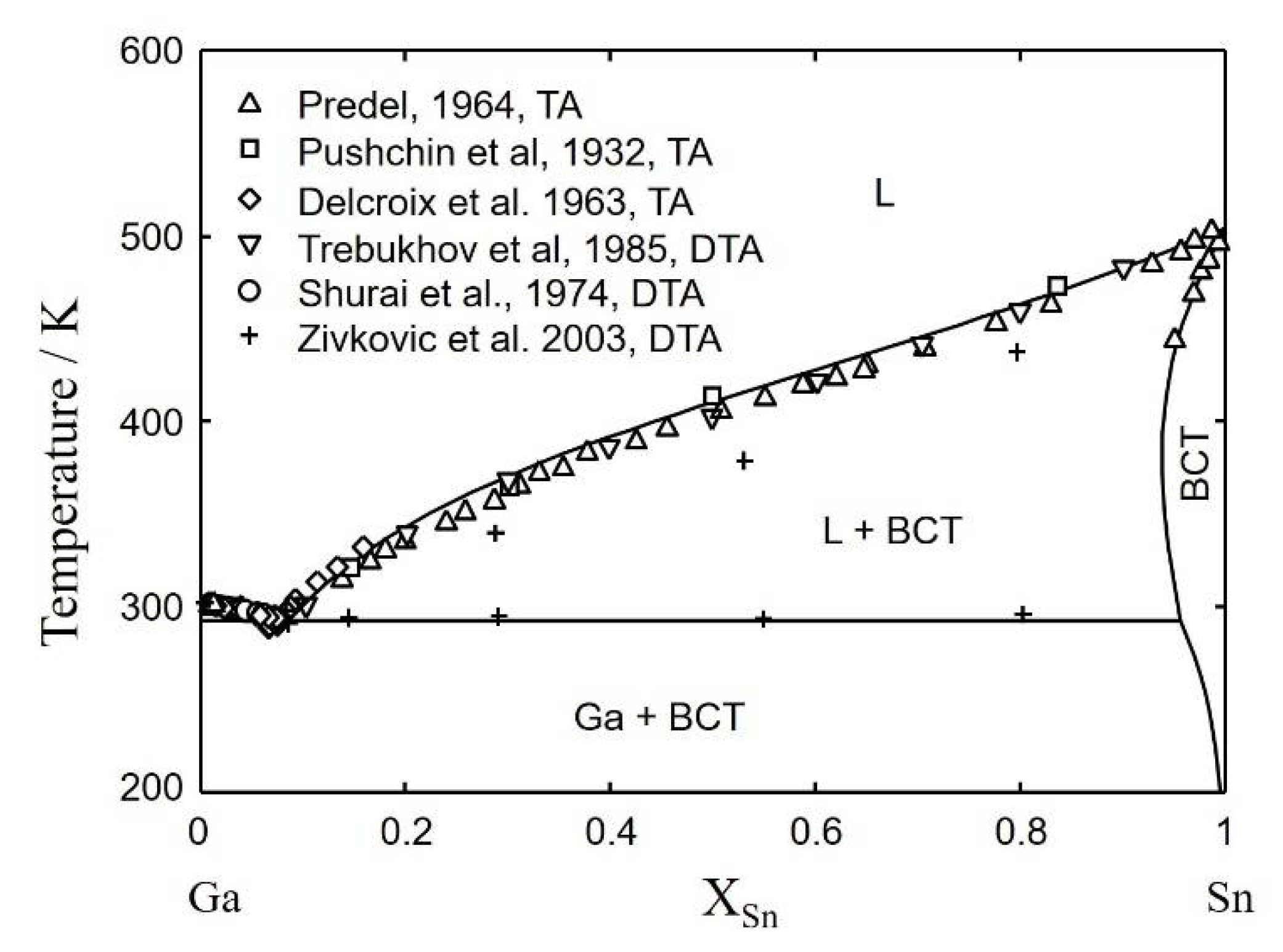Thermodynamic Optimization of the Ternary Ga-Sn-Te System Using Modified Quasichemical Model
Abstract
1. Introduction
2. Thermodynamic Models
2.1. Pure Elements and Stoichiometric Compound
2.2. Liquid Solution
2.3. Solid Solution
3. Results
3.1. Ga-Sn Binary System
3.2. Sn-Te Binary System
3.3. Ga-Te Binary System
3.4. Ga-Sn-Te Ternary System
4. Application of the Database
5. Conclusions
Author Contributions
Funding
Data Availability Statement
Acknowledgments
Conflicts of Interest
References
- Snyder, G.J.; Toberer, E.S. Complex thermoelectric materials. Nat. Mater. 2008, 7, 105–114. [Google Scholar] [CrossRef] [PubMed]
- Bell, L.E. Cooling, heating, generating power, and recovering waste heat with thermoelectric systems. Science 2008, 321, 1457–1461. [Google Scholar] [CrossRef] [PubMed]
- Uchida, K.; Takahashi, S.; Harii, K.; Ieda, J.; Koshibae, W.; Ando, K.; Maekawa, S.; Saitoh, E. Observation of the spin Seebeck effect. Nature 2008, 455, 778–781. [Google Scholar] [CrossRef] [PubMed]
- Cutler, M.; Leavy, J.F.; Fitzpatrick, R.L. Electronic transport in semimetallic cerium sulfide. Phys. Rev. 1964, 133, A1143. [Google Scholar] [CrossRef]
- Hasan, M.N.; Wahid, H.; Nayan, N.; Mohamed Ali, M.S. Inorganic thermoelectric materials: A review. Int. J. Energy Res. 2020, 44, 6170–6222. [Google Scholar] [CrossRef]
- Harman, T.C.; Walsh, M.P.; Laforge, B.E.; Turner, G.W. Nanostructured thermoelectric materials. J. Electron. Mater. 2005, 34, L19–L22. [Google Scholar] [CrossRef]
- Ikeda, T.; Toberer, E.S.; Ravi, V.A.; Haile, S.M.; Jeffrey Snyder, G. Lattice thermal conductivity of self-assembled PbTe-Sb2Te 3 composites with nanometer lamellae. In Proceedings of the 2007 26th International Conference on Thermoelectrics, Jeju, Korea, 3–7 June 2007; pp. 1–4. [Google Scholar]
- Wu, H.J.; Foo, W.J.; Chen, S.W.; Jeffrey Snyder, G. Ternary eutectic growth of nanostructured thermoelectric Ag-Pb-Te materials. Appl. Phys. Lett. 2012, 101, 023107. [Google Scholar] [CrossRef]
- Dadda, J.; Müller, E.; Perlt, S.; Höche, T.; Hermann, R.; Neubrand, A. Evolution of phase segregation and eutectic structures in AgPb18SbTe20. Phys. Status Solidi 2014, 211, 1276–1281. [Google Scholar] [CrossRef]
- Yim, J.-H.; Jung, K.; Kim, H.-J.; Park, H.-H.; Park, C.; Kim, J.-S. Effect of composition on thermoelectric properties in PbTe-Bi2Te3 composites. J. Electron. Mater. 2011, 40, 1010–1014. [Google Scholar] [CrossRef]
- Li, J.Q.; Li, L.F.; Song, S.H.; Liu, F.S.; Ao, W.Q. High thermoelectric performance of GeTe-Ag8GeTe6 eutectic composites. J. Alloys Compd. 2013, 565, 144–147. [Google Scholar] [CrossRef]
- Sootsman, J.R.; He, J.; Dravid, V.P.; Ballikaya, S.; Vermeulen, D.; Uher, C.; Kanatzidis, M.G. Microstructure and thermoelectric properties of mechanically robust PbTe-Si eutectic composites. Chem. Mater. 2010, 22, 869–875. [Google Scholar] [CrossRef]
- Cheng, Y.; Yang, J.; Jiang, Q.; He, D.; He, J.; Luo, Y.; Zhang, D.; Zhou, Z.; Ren, Y.; Xin, J. New insight into InSb-based thermoelectric materials: From a divorced eutectic design to a remarkably high thermoelectric performance. J. Mater. Chem. A 2017, 5, 5163–5170. [Google Scholar] [CrossRef]
- Femi, O.E.; Akkiraju, K.; Murthy, B.S.; Ravishankar, N.; Chattopadhyay, K. Effect of processing route on the bipolar contribution to the thermoelectric properties of n-type eutectic Bi22.5Sb7.5Te70 alloy. J. Alloys Compd. 2016, 682, 791–798. [Google Scholar] [CrossRef]
- Yang, B.; Li, S.; Li, X.; Wang, Y.; Zhong, H.; Feng, S. Microstructure and enhanced thermoelectric performance of Te–SnTe eutectic composites with self-assembled rod and lamellar morphology. Intermetallics 2019, 112, 106499. [Google Scholar] [CrossRef]
- Liu, D.; Dreβler, C.; Seyring, M.; Teichert, S.; Rettenmayr, M. Reduced thermal conductivity of Bi-In-Te thermoelectric alloys in a eutectic lamellar structure. J. Alloys Compd. 2018, 748, 730–736. [Google Scholar] [CrossRef]
- Durman, M.; Murphy, S. Precipitation of metastable ϵ-phase in a hypereutectic zinc-aluminium alloy containing copper. Acta Metall. Mater. 1991, 39, 2235–2242. [Google Scholar] [CrossRef]
- Spinelli, J.E.; Silva, B.L.; Garcia, A. Microstructure, phases morphologies and hardness of a Bi-Ag eutectic alloy for high temperature soldering applications. Mater. Des. 2014, 58, 482–490. [Google Scholar] [CrossRef]
- Wu, X.F.; Wang, K.Y.; Wu, F.F.; Zhao, R.D.; Chen, M.H.; Xiang, J.; Ma, S.N.; Zhang, Y. Simultaneous grain refinement and eutectic Mg2Si modification in hypoeutectic Al-11Mg2Si alloys by Sc addition. J. Alloys Compd. 2019, 791, 402–410. [Google Scholar] [CrossRef]
- Blanco-Rodríguez, P.; Rodríguez-Aseguinolaza, J.; Risueño, E.; Tello, M. Thermophysical characterization of Mg-51%Zn eutectic metal alloy: A phase change material for thermal energy storage in direct steam generation applications. Energy 2014, 72, 414–420. [Google Scholar] [CrossRef]
- Li, S.L.; Song, J.M.; Uan, J.Y. Mg-Mg2X (X=Cu, Sn) eutectic alloy for the Mg2X nano-lamellar compounds to catalyze hydrolysis reaction for H2 generation and the recycling of pure X metals from the reaction wastes. J. Alloys Compd. 2019, 772, 489–498. [Google Scholar] [CrossRef]
- Tan, G.; Hao, S.; Hanus, R.C.; Zhang, X.; Anand, S.; Bailey, T.P.; Rettie, A.J.E.; Su, X.; Uher, C.; Dravid, V.P.; et al. High thermoelectric performance in SnTe-AgSbTe2 alloys from lattice softening, giant phonon-vacancy scattering, and valence band convergence. ACS Energy Lett. 2018, 3, 705–712. [Google Scholar] [CrossRef]
- Zhang, Q.; Liao, B.; Lan, Y.; Lukas, K.; Liu, W.; Esfarjani, K.; Opeil, C.; Broido, D.; Chen, G.; Ren, Z. High thermoelectric performance by resonant dopant indium in nanostructured SnTe. Proc. Natl. Acad. Sci. USA 2013, 110, 13261–13266. [Google Scholar] [CrossRef]
- Moshwan, R.; Yang, L.; Zou, J.; Chen, Z.-G. Eco-Friendly SnTe thermoelectric materials: Progress and future challenges. Adv. Funct. Mater. 2017, 27, 1703278. [Google Scholar] [CrossRef]
- Li, S.; Li, X.; Ren, Z.; Zhang, Q. Recent progress towards high performance of tin chalcogenide thermoelectric materials. J. Mater. Chem. A 2018, 6, 2432–2448. [Google Scholar] [CrossRef]
- Al Rahal Al Orabi, R.; Hwang, J.; Lin, C.C.; Gautier, R.; Fontaine, B.; Kim, W.; Rhyee, J.S.; Wee, D.; Fornari, M. Ultralow lattice thermal conductivity and enhanced thermoelectric performance in SnTe:Ga materials. Chem. Mater. 2017, 29, 612–620. [Google Scholar] [CrossRef]
- Pelton, A.D.; Degterov, S.A.; Eriksson, G.; Robelin, C.; Dessureault, Y. The modified quasichemical model I—Binary solutions. Metall. Mater. Trans. B 2000, 31, 651–659. [Google Scholar] [CrossRef]
- Pelton, A.D.; Chartrand, P. The modified quasi-chemical model: Part II. multicomponent solutions. Met. Mater. Trans. A 2001, 32, 1355–1360. [Google Scholar] [CrossRef]
- Kumar, B.; Paek, M.-K.; Tiwary, C.S.; Paliwal, M. Thermodynamic modeling of the ternary Bi-Ga-Te system for potential application in thermoelectric materials. Calphad 2021, 74, 102326. [Google Scholar] [CrossRef]
- Bale, C.W.; Chartrand, P.; Degterov, S.A.; Eriksson, G.; Hack, K.; Mahfoud, R.B.; Petersen, S. FactSage: Thermochemical software and databases. Calphad 2002, 26, 189–228. [Google Scholar] [CrossRef]
- Bale, C.W.; Bélisle, E.; Chartrand, P.; Decterov, S.A.; Eriksson, G.; Hack, K.; Jung, I.H.; Kang, Y.B.; Melançon, J.; Pelton, A.D.; et al. FactSage thermochemical software and databases-recent developments. Calphad 2009, 33, 295–311. [Google Scholar] [CrossRef]
- Dinsdale, A.T. SGTE data for pure elements. Calphad 1991, 15, 317–425. [Google Scholar] [CrossRef]
- Kopp, H. Investigations of the specific heat of solid bodies. Philos. Trans. R. Soc. Lond. 1865, 155, 71–202. [Google Scholar] [CrossRef]
- Hillert, M. The compound energy formalism. J. Alloys Compd. 2001, 320, 161–176. [Google Scholar] [CrossRef]
- Anderson, T.J.; Ansara, I. The Ga-Sn (Gallium-Tin) System. J. Phase Equilibria 1992, 13, 181–189. [Google Scholar] [CrossRef]
- Kulawik, S.; Gierlotka, W.; Dębski, A.; Gąsior, W.; Zajączkowski, A. Thermodynamic assessment of the Ga-Sn-Zn system. Calphad 2020, 69, 101765. [Google Scholar] [CrossRef]
- Delcroix, S.; Defrain, A.; Epelboin, I. Sur les diagrammes d’alliages du gallium I ou II avec l’étain, le zinc ou l’indium. J. Phys. Radium 1963, 24, 17–20. [Google Scholar] [CrossRef][Green Version]
- Predel, B. Zustandsdiagramm und eigenschaften von Gallium-Zinn-Legierungen. J. Less-Common Met. 1964, 7, 347–355. [Google Scholar] [CrossRef]
- Pushin, N.; Stepanovic, S.; Stajic, V. Über die Legierungen des Galliums mit Zink, Cadmium, Quecksilber, Zinn, Blei, Wismut und Aluminium. Z. Anorg. Chem. 1932, 209, 329–334. [Google Scholar] [CrossRef]
- Shurai, P.; Danilin, V.; Sryvalin, I.T. A quanti-tative thermographic study of the phase diagram for the gallium-indium-tin system. Zh. Fiz. Khim. 1974, 48, 1325. [Google Scholar]
- Trebukhov, A.; Sarmurzina, R.G.; Sokol’skii, D.V. Study of the physico-chemical properties of the gallium-tin system. Zh. Fiz. Khim. 1985, 59, 2065–2067. [Google Scholar]
- Živković, D.; Manasijević, D.; Živković, Z. Thermodynamic study of Ga-Sn and Ga-Zn systems using quantitative differential thermal analysis. J. Therm. Anal. Calorim. 2003, 74, 85–96. [Google Scholar] [CrossRef]
- Audit, P.; Epelboin, I.; Erny, M. Determination of the solubility of tin in gallium by measurement of the electrical resistance. Mém. Sci. Rev. Métall. 1962, 59, 233–239. [Google Scholar]
- Bosio, L.; Defrain, A.; Erny, M.; Lignel, S.; Epelboin, I. Influence of Impurities on supercooling, solidification and melting of Ga. Mdm. Sci. Rev. Mdtall. 1961, 58, 43–51. [Google Scholar]
- Danilin, V.; Yatsenko, S. Use of the EMF Method to improve the accuracy of the Ga-Sn phase diagram. Russ. Met. 1968, 5, 137–139. [Google Scholar]
- Katayama, I.; Maki, K.; Nakano, M.; Iida, T. Thermodynamic activity in liquid Ga-Sn alloys studied by EMF method. Mater. Trans. JIM 1996, 37, 988–990. [Google Scholar] [CrossRef]
- Bros, J.; Castanet, R.; Laffitte, M. Enthalpy of mixing of liquid gallium-indium and gallium-tin alloys at 469 °C. CR Acad. Sci. 1967, 264, 1804–1806. [Google Scholar]
- Bros, J.; Laffitte, M. Thermodynamic study of gallium-tin alloys. J. Chim. Phys. 1970, 67, 1636–1642. [Google Scholar] [CrossRef]
- Gambino, M.; Bros, J.P.; Ajersch, F.; Ansara, I. Contribution à l’étude thermodynamique du système bismuth-gallium. Thermochim. Acta 1976, 14, 305–313. [Google Scholar] [CrossRef]
- Predel, B.; Frebel, M.; Gust, W. Untersuchung der thermodynamisches eigenschaften flussiger gallium-zinn und gallium-wismut-legierungen. J. Less Common Met. 1969, 17, 391–402. [Google Scholar] [CrossRef]
- Skoropanov, A.S.; Mechkovskii, L.A.; Zakharov, D.M.; Vecher, A.A. Measurement of the enthalpy of mixing in the gallium-indium--tin system by quantitative differential thermal analysis. Russ. J. Phys. Chem. (Engl. Transl.) 1973, 47, 426–427. [Google Scholar]
- Hsieh, K.C.; Wei, M.S.; Chang, Y.A. Thermodynamic analysis of the tin-tellurium system and calculation of the phase diagram. Z. Met. 1983, 74, 330–337. [Google Scholar]
- Kattner, U.; Lukas, H.L.; Petzow, G. Optimization and calculation of the Sn-Te system. J. Less-Common Met. 1985, 114, 129–144. [Google Scholar] [CrossRef]
- Kuznetsov, V.L. System Sn-Te: Critical evaluation and optimization of data on the thermodynamic properties and phase diagram. Inorg. Mater. 1996, 32, 231–242. [Google Scholar]
- Merzhanov, I.; Goryacheva, V.I.; Gejderikh, V.A. Optimization of data on thermodynamic properties and phase diagram for the tin-telluium system. Vestn. Mosk. Univ. Seriya 2 Khimiya 1988, 29, 471–474. [Google Scholar]
- Liu, Y.; Liang, D.; Zhang, L. Thermodynamic descriptions for the Sn-Te and Pb-Sn-Te systems. J. Electron. Mater. 2010, 39, 246–257. [Google Scholar] [CrossRef]
- Sharma, R.C.; Chang, Y.A. The Sn-Te (Tin-Tellurium) system. Bull. Alloy Phase Diagr. 1986, 7, 72–80. [Google Scholar] [CrossRef]
- Biltz, W.; Mecklenburg, W. Über die Zustandsdiagramme von Zinn mit Schwefel, Selen und Tellur. Z. Anorg. Chem. 1909, 64, 226–235. [Google Scholar] [CrossRef]
- Kobayashi, M. Über die Legierungen des Tellurs mit Cadmium und Zinn. Z. Anorg. Chem. 1911, 69, 1–9. [Google Scholar] [CrossRef]
- Umeda, J.; Jeong, M.; Okada, T. Tin-Tellurium phase diagram in the vicinity of stannous telluride SnTe. Jpn. J. Appl. Phys. 1962, 1, 277–282. [Google Scholar] [CrossRef]
- Harris, J.S.; Gertner, E.R.; Clarke, J.E. The PbSn-Te phase diagram and its application to the liquid phase epitaxial growth of Pb1-xSnxTe. J. Cryst. Growth 1975, 28, 334–342. [Google Scholar] [CrossRef]
- Brebrick, R.F.; Strauss, A.J. Partial pressures in equilibrium with group IV tellurides. II. tin telluride. J. Chem. Phys. 1964, 197–205. [Google Scholar] [CrossRef]
- Rakotomavo, J.; Baron, M.C.; Petot, C. Thermodynamic properties of liquid tin-tellurium alloys at high temperature. Metall. Trans. B 1981, 12, 461–467. [Google Scholar] [CrossRef]
- Bouteiller, M.L.; Martre, A.M.; Farhi, R.; Petot, C. Thermodynamic measurements in liquid tin-tellurium alloys. Metall. Trans. B 1977, 8B, 339–343. [Google Scholar] [CrossRef]
- Kurosawa, S.; Nakamura, Y.; Shimoji, M. The electrical conductivity and the phase diagram of the molten tin-tellurium system. J. Less-Common Met. 1980, 70, 119–121. [Google Scholar] [CrossRef]
- Brebrick, R.F. Deviations from stoichiometry and electrical properties in SnTe. J. Phys. Chem. Solids 1963, 24, 27–36. [Google Scholar] [CrossRef]
- Brebrick, R.F. Composition stability limits rocksalt-structure from lattice parameter. J. Phys. Chem. Solids 1971, 32, 551–562. [Google Scholar] [CrossRef]
- Shelimova, L.E.; Abrikosov, N.K. The Sn−Te system in the region of the compound SnTe. Russ. J. Inorg. Chem. 1964, 9, 1017–1020. [Google Scholar]
- Sha, Y.G.; Brebrick, R.F. Explicit incorporation of the energy-band structure into an analysis of the defect chemistry of PbTe and SnTe. J. Electron. Mater. 1989, 18, 421–443. [Google Scholar] [CrossRef]
- Rogacheva, E.; Dzyubenko, N.I. Solubility of impurities in nonstoichiometric SnTe. Izv. Akad. Nauk SSSR Neorg. Mater. 1986, 22, 760–761. [Google Scholar]
- Rogacheva, E.I.; Gorne, G.V.; Zhigareva, N.K.; Ivanova, A.B. Homogeneity region of tin monotelluride. Izv. Akad. Nauk SSSR, Neorg. Mater. 1991, 27, 267–270. [Google Scholar]
- Nakamura, Y.; Himuro, S.; Shimoji, M. Thermodynamic study on compound-forming molten alloys: The tin-tellurium system. Berichte der Bunsenges. Phys. Chem. Chem. Phys. 1980, 84, 240–244. [Google Scholar] [CrossRef]
- Predel, B.; Piehl, J.; Pool, M.J. Contribution to the thermodynamic properties of liquid binary alloys of Te with Sn, Pb and Bi. Z. Fuer Met. 1975, 66, 347–352. [Google Scholar]
- Amzil, A.; Mathieu, J.C.; Castanet, R. Experimental determination of the partial enthalpies of mixing of tin and tellurium in Sn-Te melts. J. Alloys Compd. 1996, 235, 124–127. [Google Scholar] [CrossRef]
- Blachnik, R.; Gather, B. Die Mischungsenthalpien im System Zinn-Tellur. Z. Fuer Met. 1983, 74, 172–176. [Google Scholar]
- Mcateer, J.H.; Seltz, H. Thermodynamic properties of the tellurides of Zinc, cadmium, tin and lead. J. Am. Chem. Soc. 1936, 58, 2081–2084. [Google Scholar] [CrossRef]
- Robinson, P.; Bever, M. On the thermodynamic properties of the tellurides of the cadmium, indium, tin, and lead. AIME Trans. 1966, 236, 814–817. [Google Scholar]
- Vecher, A.A.; Mechkovskii, L.A.; Skoropanov, A.S. Determination of heats of formation of some tellurides. Izv. Akad. Nauk SSSR Neorg. Mater. 1974, 10, 2140–2143. [Google Scholar]
- Misra, S. A Thermoanalytical investigation of the thermodynamic properties of tin telluride. J. Therm. Anal. 1975, 7, 309–316. [Google Scholar]
- Colin, B.R.; Drowart, J. Thermodynamic study of tin selenide and tin telluride using a mass spectrometer*. Trans. Faraday Soc. 1963, 60, 673–683. [Google Scholar] [CrossRef]
- Blachnik, R.; Igel, R.; Wallbrecht, P. Thermodynamische eigenschaften von zinnchalcogeniden. Z. Nat. 1974, 29, 1198–1201. [Google Scholar]
- Medzhidov, R.A.; Rasulov, S.M. Point defects contribution into SnTe and Sb/sub 2/Te/sub 3/ surplus enthalpy, heat capacity and entropy. Zh. Fiz. Khim. 1979, 53, 191–192. [Google Scholar]
- Yamaguchi, K.; Kameda, K.; Takeda, Y.; Itagaki, K. Measurements of high temperature heat content of the II-VI and IV-VI (II:Zn, Cd IV: Sn, Pb VI: Se, Te) compounds. Mater. Trans. JIM 1994, 35, 118–154. [Google Scholar] [CrossRef][Green Version]
- Pashinkin, A.S.; Malkova, A.S.; Mikhailova, M.S. Standard enthalpy and heat capacity of solid tin telluride. Russ. J. Phys. Chem. A 2006, 80, 1342–1343. [Google Scholar] [CrossRef]
- Dedegkaev, T.T.; Duguzhev, S.M.; Zhukova, T.B.; Melekh, B.T.; Moshnikov, V.A. Production and investigation of composition and structure of new SnGa6Te10 compounds. Zhurnal Tekhnicheskoi Fiz. 1985, 55, 2408–2410. [Google Scholar]
- Gather, B.; Irle, E.; Blachnik, R. The excess enthalpies of liquid Ga-Ge-Te and Ga-Sn-Te alloys. J. Less-Common Met. 1987, 136, 183–191. [Google Scholar] [CrossRef]
- Rustamov, P.G.; Kuliev, B.B.; Aliyanov, M.A.; Kuliev, E.M. On Interaction of Tin Telluride with GaTe. Phys. Status Solidi 1970, 3, K139–K141. [Google Scholar] [CrossRef]
- Dovletov, K.; Ehrniyazov, K.; Malkova, A.S. Phase equilibria in the GaTe-SnTe-, InTe-SnTe systems. Izv. Akad. Nauk SSSR Neorg. Mater. 1976, 12, 1964–1968. [Google Scholar]
- Guittard, M.; Alapini, F.; Jaulmes, S.; Julien-Pouzol, M.; Flahaut, J. Sur une famille de tellurures ternaires formes par le gallium avec l’etain ii, le plomb ou l’indium i, de type SnGa6Te10. Mater. Res. Bull. 1978, 13, 1157–1161. [Google Scholar] [CrossRef]
- Alapini, F.; Flahaut, J.; Guittard, M.; Jaulmes, S.; Julien-Pouzol, M. Systeme gallium-tellure: Diagrammes de phases, étude structurale de GaTe, Ga2Te5 et de Ga6SnTe10. J. Solid State Chem. 1979, 28, 309–319. [Google Scholar] [CrossRef]
- Pelton, A.D. A general “geometric” thermodynamic model for multicomponent solutions. Calphad 2001, 25, 319–328. [Google Scholar] [CrossRef]
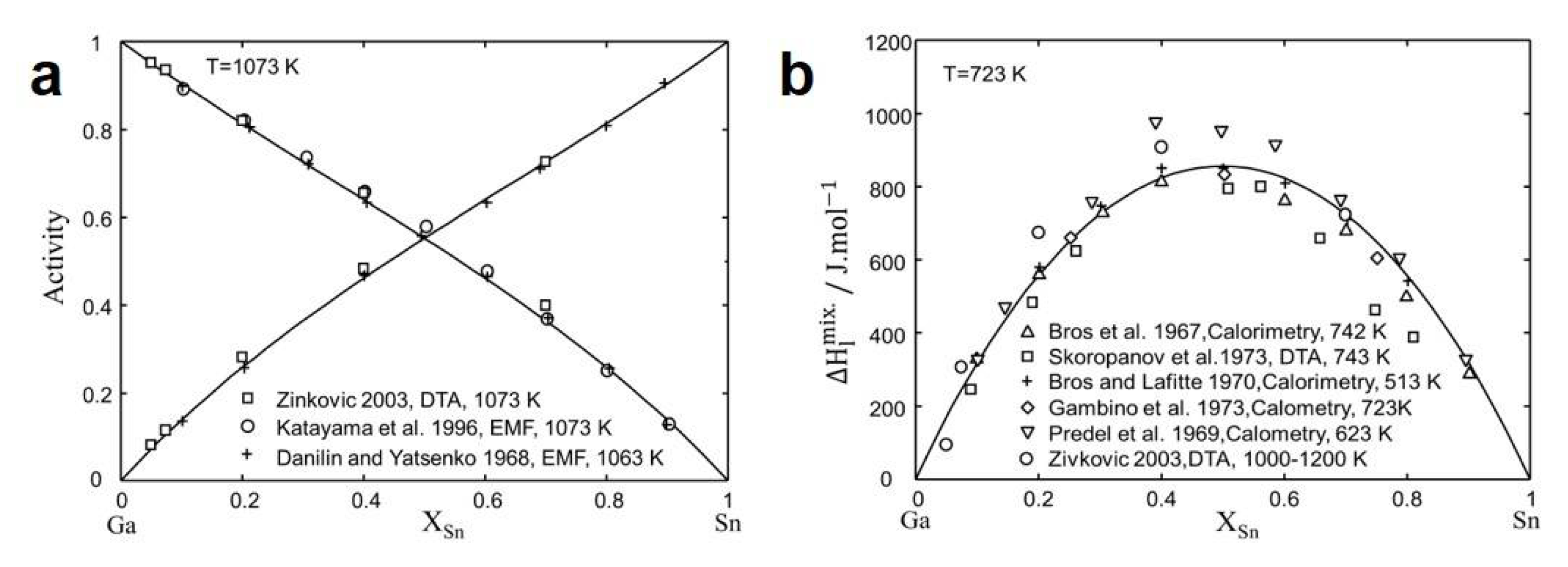
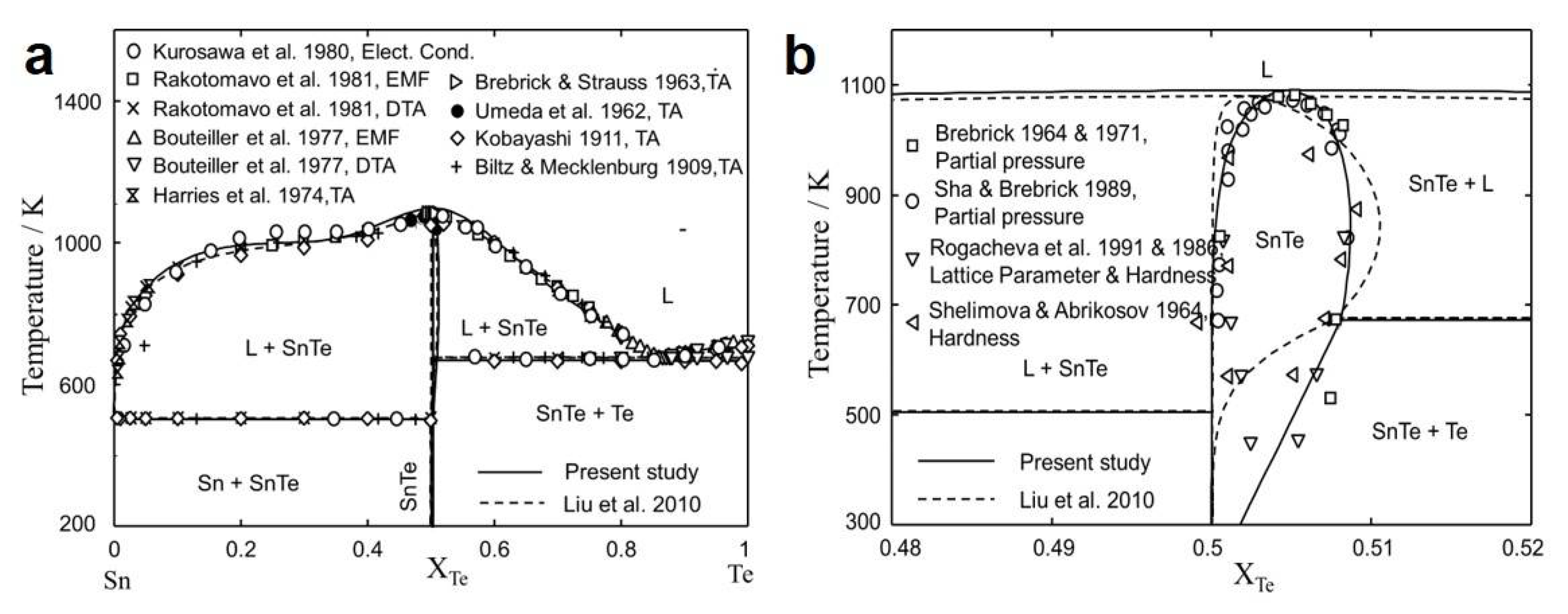
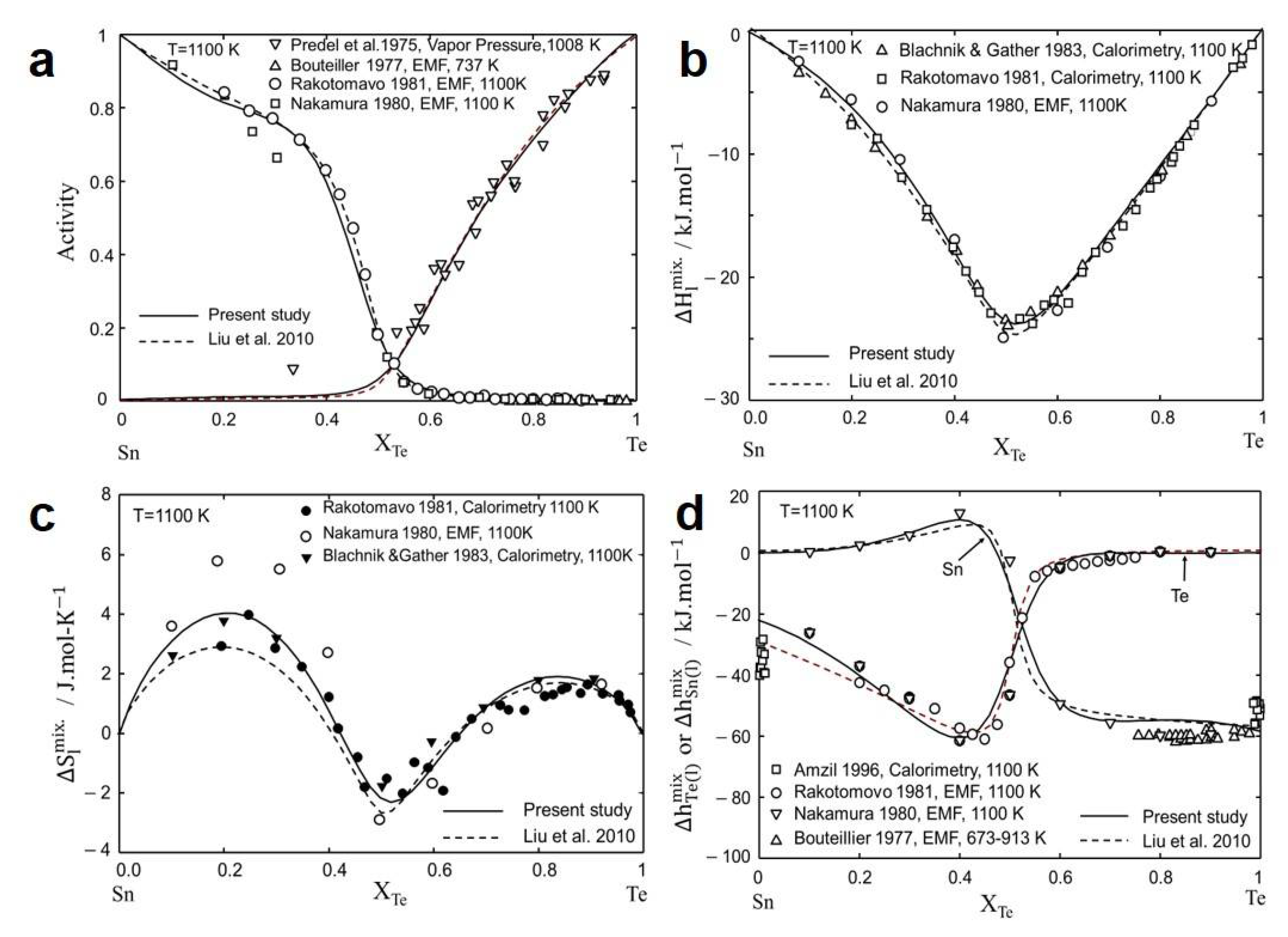

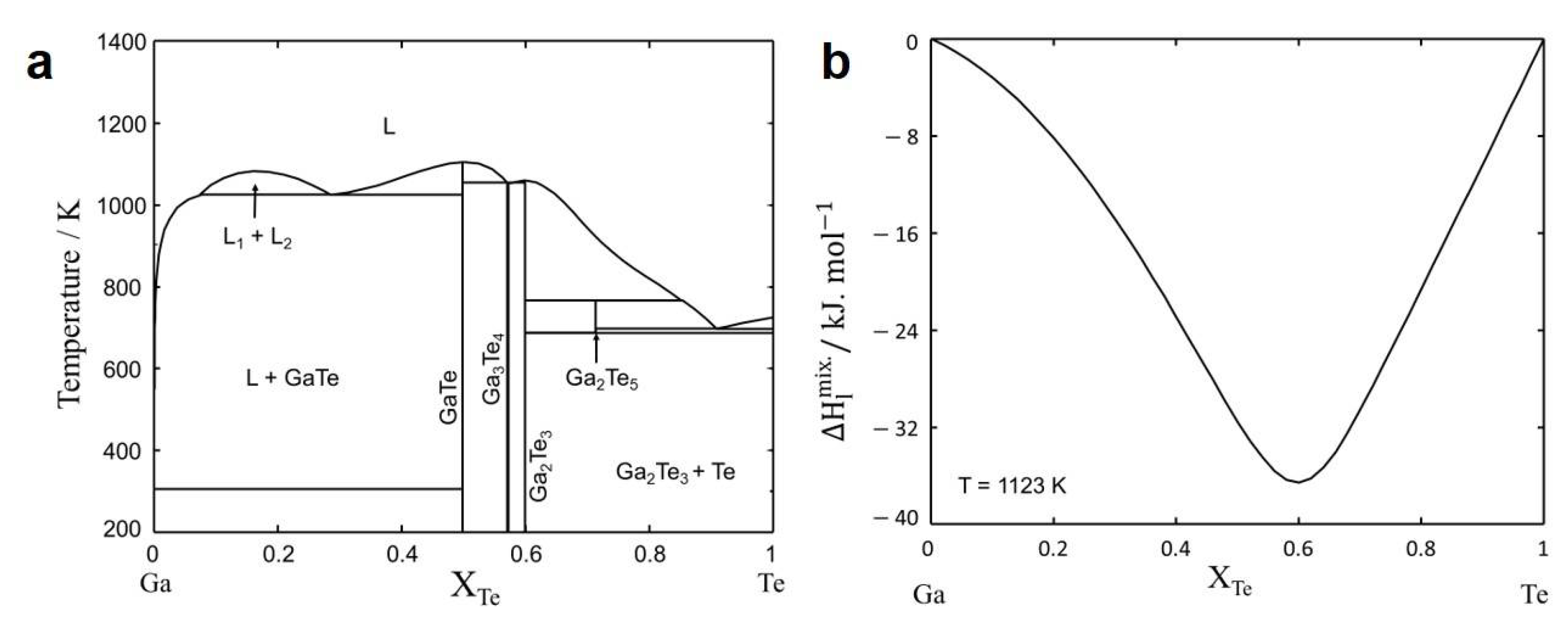
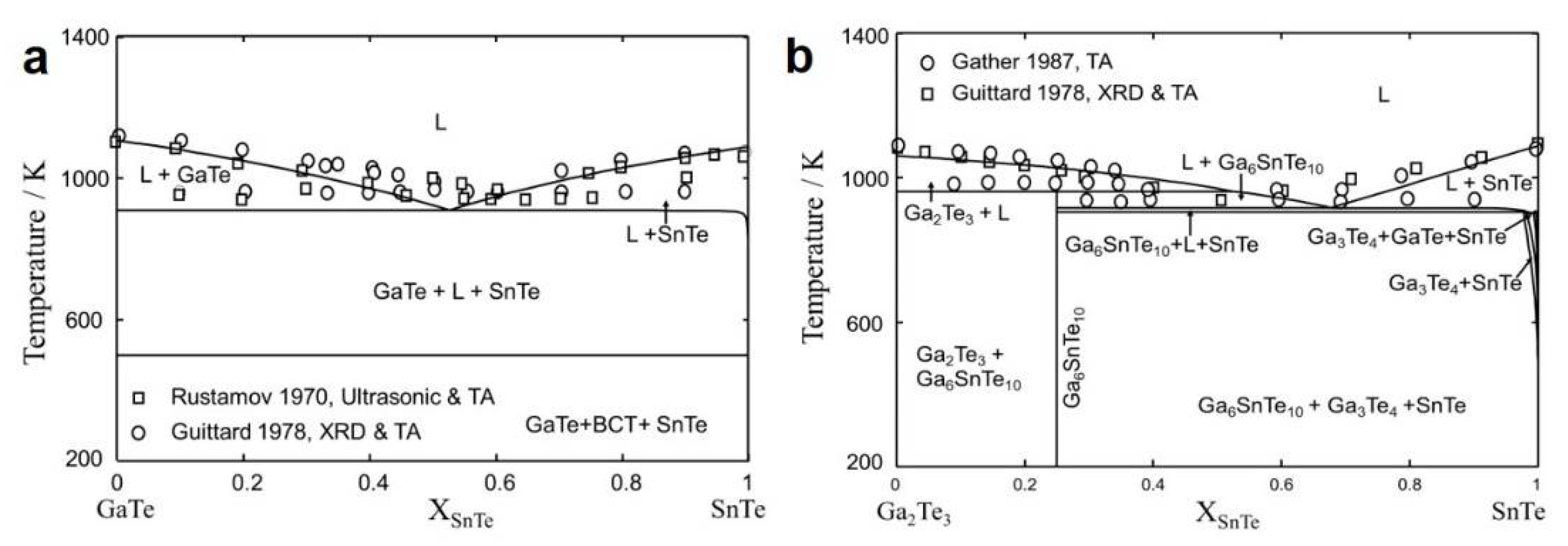
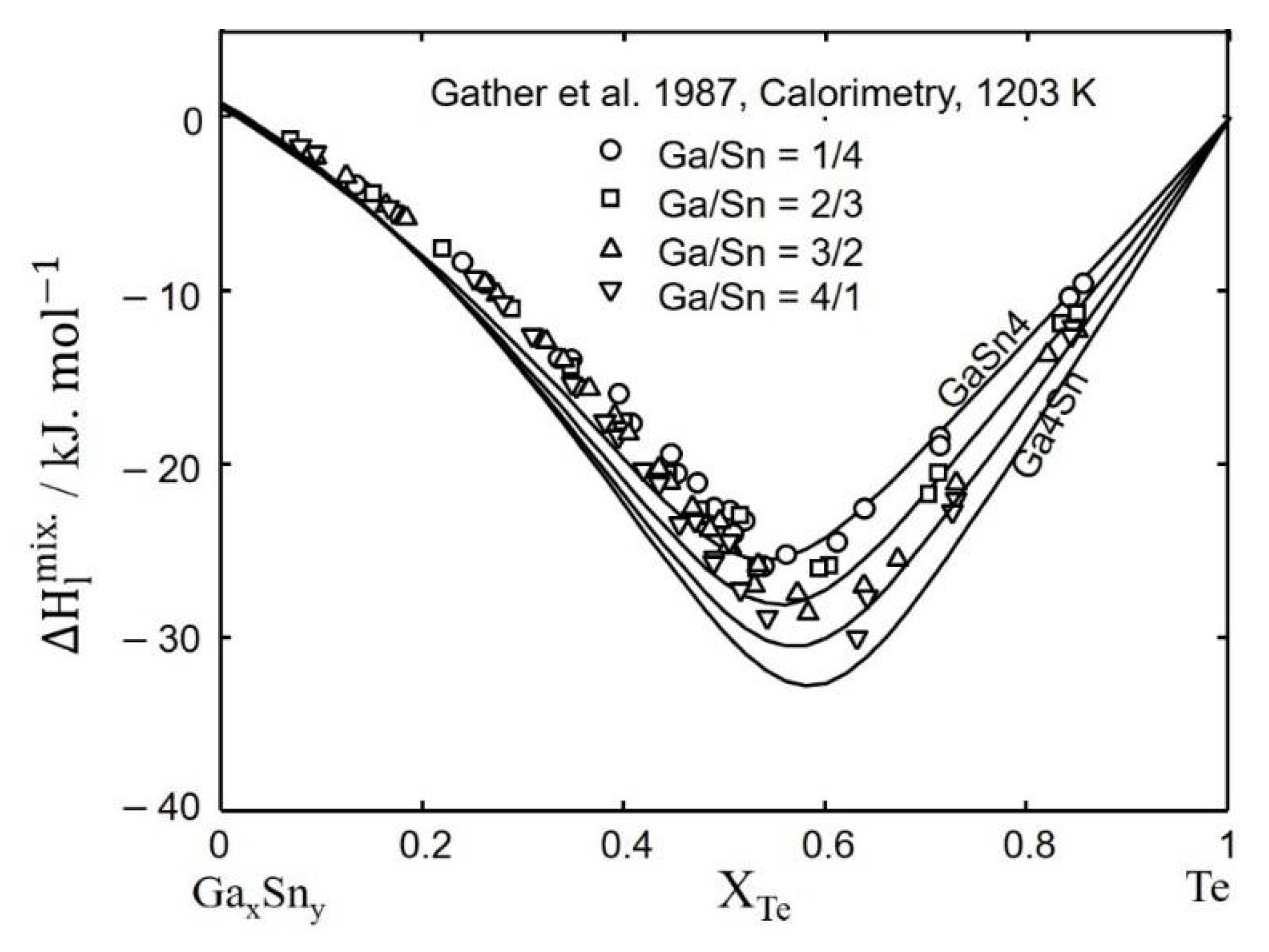
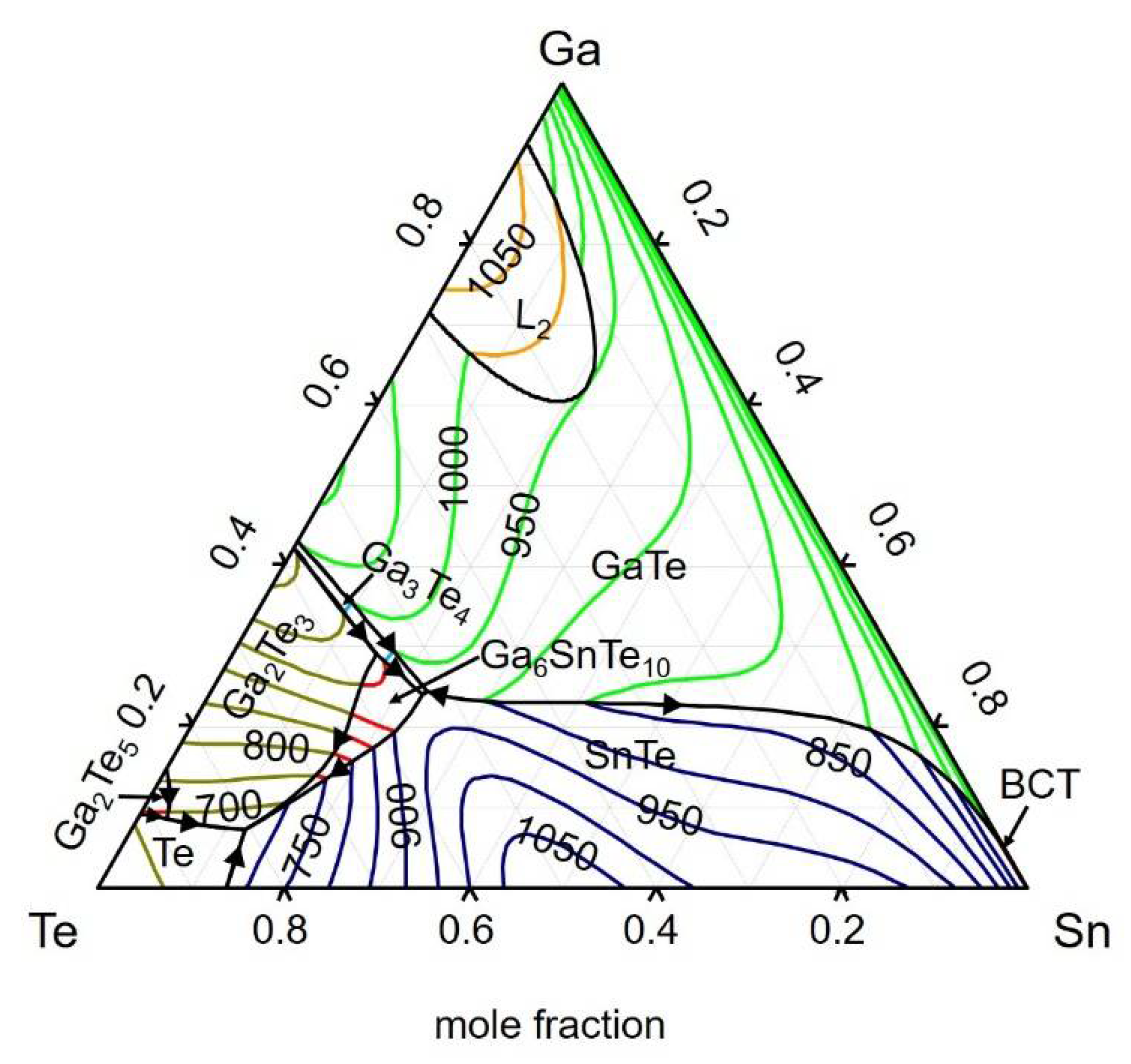

| Phase/Model | Thermodynamic Parameters (J/mol) | Ref. |
|---|---|---|
| Liquid (Sn, Ga, Te) Modified Quasichemical Model | ||
| = 1200 | This work | |
| = | This work | |
| [29] | ||
| = −8900 | This work | |
| BCT (Sn, Ga) | = | |
| Regular Solution Model | This work | |
| = | ||
| SnTe (Sn, Va) (Te) Compound Energy Formalism | 60127.45 | |
| + 10000 | This work | |
| ) | ||
| Intermetallic Compounds | ||
| Phase | Thermodynamic Parameters (J/mol) | |
| GaTe | -- (50 < T < 298) | [29] |
| -- (298 < T < 1600) | ||
| Ga2Te3 | - (50 < T < 298) | [29] |
(298 < T < 1600) | ||
| Ga3Te4 | - (50 < T < 298) | [29] |
(298 < T < 1600) | ||
| Ga2Te5 | T (298 < T < 1600) | [29] |
| Ga6SnTe10 | T (298 < T < 4000) | This work |
| Method | Reference | |
|---|---|---|
| −61.29 | Potentiometry | Mcateer & Harry [76] |
| −60.7 | Calorimetry | Robinson & Bever [77] |
| −64.2 | Calorimetry | Vecher et al. [78] |
| −59.83 | Calorimetry | Misra [79] |
| −61.08 | Mass spectrometer | Colin & Drowart [80] |
| −60.1 | Calculated | Liu et al. [56] |
| −60.1 | Calculated | Present study |
| Sr. No. | Reaction | Type | Composition | T(K) | ||
|---|---|---|---|---|---|---|
| 1 | Peritectic | 0.290 | 0.556 | 0.154 | 957.95 | |
| 2 | Quasi Peritectic | 0.240 | 0.531 | 0.229 | 904.13 | |
| 3 | Eutectic | 0.243 | 0.523 | 0.234 | 901.28 | |
| 4 | Quasi Peritectic | 0.086 | 0.884 | 0.03 | 686.36 | |
| 5 | Quasi Peritectic | 0.072 | 0.807 | 0.121 | 654.76 | |
| 6 | Eutectic | 0.03 | 4.6E-4 | 0.967 | 498.08 | |
Publisher’s Note: MDPI stays neutral with regard to jurisdictional claims in published maps and institutional affiliations. |
© 2021 by the authors. Licensee MDPI, Basel, Switzerland. This article is an open access article distributed under the terms and conditions of the Creative Commons Attribution (CC BY) license (https://creativecommons.org/licenses/by/4.0/).
Share and Cite
Kumar, B.; Paliwal, M.; Tiwary, C.S.; Paek, M.-K. Thermodynamic Optimization of the Ternary Ga-Sn-Te System Using Modified Quasichemical Model. Metals 2021, 11, 1363. https://doi.org/10.3390/met11091363
Kumar B, Paliwal M, Tiwary CS, Paek M-K. Thermodynamic Optimization of the Ternary Ga-Sn-Te System Using Modified Quasichemical Model. Metals. 2021; 11(9):1363. https://doi.org/10.3390/met11091363
Chicago/Turabian StyleKumar, Bhupendra, Manas Paliwal, Chandra Sekhar Tiwary, and Min-Kyu Paek. 2021. "Thermodynamic Optimization of the Ternary Ga-Sn-Te System Using Modified Quasichemical Model" Metals 11, no. 9: 1363. https://doi.org/10.3390/met11091363
APA StyleKumar, B., Paliwal, M., Tiwary, C. S., & Paek, M.-K. (2021). Thermodynamic Optimization of the Ternary Ga-Sn-Te System Using Modified Quasichemical Model. Metals, 11(9), 1363. https://doi.org/10.3390/met11091363






